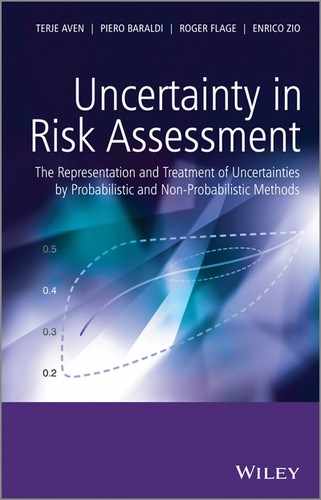Preface
The aim of this book is to critically present the state of knowledge on the treatment of uncertainties in risk assessment for practical decision-making situations concerning high-consequence technologies, for example, nuclear, oil and gas, transport, and so on, and the methods for the representation and characterization of such uncertainties. For more than 30 years, probabilistic frameworks and methods have been used as the basis for risk assessment and uncertainty analysis, but there is a growing concern, partly motivated by newly emerging risks like those related to security, that extensions and advancements are needed to effectively treat the different sources of uncertainty and related forms of information. Alternative approaches for representing uncertainty have been proposed, for example, those based on interval probability, possibility, and evidence theory. It is argued that these approaches provide a more adequate treatment of uncertainty in situations of poor knowledge of the phenomena and scenarios studied in the risk assessment. However, many questions concerning the foundations of these approaches and their use remain unanswered.
In this book, we present a critical review and discussion of methods for the representation and characterization of the uncertainties in risk assessment. Using examples, we demonstrate the applicability of the various methods and point to their strengths and weaknesses in relation to the situation addressed. Today, no authoritative guidance exists on when to use probability and when to use an alternative representation of uncertainty, and we hope that the present book can provide a platform for the development of such guidance. The areas of potential application of the theories and methods studied in the book are broad, ranging from engineering and medicine to environmental impacts and natural disasters, security, and financial risk management. Our main focus, however is, on engineering applications.
The topic of uncertainty representation and characterization is conceptually and mathematically challenging, and much of the existing literature in the field is not easily accessible to engineers and risk analysts. One aim of the present book is to provide a relatively comprehensive state of knowledge, with strong requirements for rigor and precision, while striving for readability by a broad audience of professionals in the field, including researchers and graduate students.
Readers will require some fundamental background in risk assessment, as well as basic knowledge of probability theory and statistics. The goal, however, has been to reduce the dependency on extensive prior knowledge, and key probabilistic and statistical concepts will be introduced and discussed thoroughly in the book.
It is with sincere appreciation that we thank all those who have contributed to the preparation of this book. In particular, we are grateful to Drs. Francesco Cadini, Michele Compare, Jan Terje Kvaløy, Giovanni Lonati, Irina Crenguza Popescu, Ortwin Renn, and Giovanna Ripamonti for contributing the research that has provided the material for many parts of the book, and to Andrea Prestigiacomo for his careful editing work. We also acknowledge the editing and production staff at Wiley for their careful and effective work.
Terje Aven
Roger Flage Stavanger
Piero Baraldi Milano
Enrico Zio Paris
June 2013
